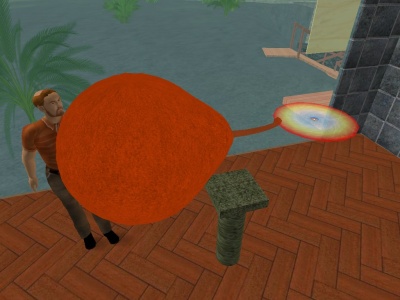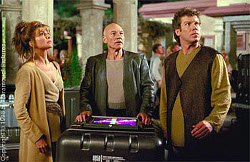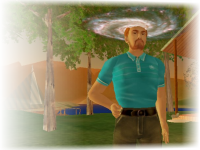An Updated Bill of Rights for the Modern Era
Posted on June 2nd, 2010 — permalink
It has come to my attention that the first ten amendments of the US Constitution are no longer consistent with how we, the People of the United States, run our society. As such, I offer the following corrected versions of several of the amendments:
- First Amendment
-
Congress shall make no law respecting an establishment of religion, or prohibiting the free exercise thereof, except south of the Mason-Dixon line, where those who have not accepted Jesus as their Lord and Savior are damned; or abridging the freedom of speech, or of the press, except when that freedom of expression threatens the business model of large congressional campaign donors; or the right of the people peaceably to assemble, and to petition the Government for a redress of grievances, as long as they can afford a laywer.
- Second Amendment
-
A well regulated Militia, being necessary to the security of a free State, the right of the people to keep and bear Arms, shall not be infringed, except in districts where an anti-gun stance will assist in the re-election of lawmakers
- Fourth Amendment
-
The right of the people to be secure in their persons, houses, papers, and effects, against unreasonable searches and seizures, shall not be violated, and no Warrants shall issue, but upon probable cause, supported by Oath or affirmation, and particularly describing the place to be searched, and the persons or things to be seized. This Amendment is Void in Arizona, and also in any case where we might be afraid of the possibility of terrorism, including anything having anything to do with a computer or an airplane.
- Fifth Amendment
-
No person shall be held to answer for any capital, or otherwise infamous crime, unless on a presentment or indictment of a Grand Jury, except in cases arising in the land or naval forces, or in the Militia, when in actual service in time of War or public danger, or when that person isn’t an American, or where somebody somewhere thinks that person might have been connected to terrorism; nor shall any person be subject for the same offense to be twice put in jeopardy of life or limb; nor shall be compelled in any criminal case to be a witness against himself, nor be deprived of life, liberty, or property, without due process of law, except in cases where somebody somewhere thinks that the person might have been connected to terrorism or something we’ve chosen to call terrorism; nor shall private property of large congressional campaign donors be taken for public use, without just compensation.
- Sixth Amendment
-
In all criminal prosecutions, the accused shall enjoy the right to a speedy and public trial, except in cases where somebody somewhere believes that the accused might have something to do with terrorism, by an impartial jury of the State and district where in the crime shall have been committed, which district shall have been previously ascertained by law, and to be informed of the nature and cause of the accusation; to be confronted with the witnesses against him; to have compulsory process for obtaining witnesses in his favor, and to have the Assistance of Counsel for his defense.
- Eighth Amendment
-
Excessive bail shall not be required, nor excessive fines imposed, nor cruel and unusual punishments inflicted, except in a country where Jack Bauer saved the world in a fictional narrative by the application of such methods.
- Ninth Amendment
-
The enumeration in the Constitution, of certain rights, shall not be construed to deny or disparage others retained by large congressional campaign donors.
- Tenth Amendment
-
The powers not delegated to the United States by the Constitution, nor prohibited by it to the States, are reserved to large corporate congressional campaign donors.
3 Comments
Ia Supernovae : colliding white dwarfs, not accreting white dwarfs!
Posted on February 18th, 2010 — permalink
My world has been rocked.
A paper by Gilfanov and Bogdan, and an accompanying press release yesterday from the Chandra Space Telescope, presents results that suggest that the progenitors of Type Ia supernovae are not what most of us have assumed all along. Before I go any further, I want to make it clear that this doesn’t call into question any of the results that have used Type Ia supernovae as standard candles, including the observation that the expansion of the Universe is accelerating. Those results don’t depend on what Ia supernovae are; they depend on the empirically observed fact that the luminosities of the explosions are remarkably consistent. Of course, if we really want to push those observations further, we need to understand the objects better, so that we can deal with outliers and exceptions, but the core results remain robust.
But, of course, as with everything in the Universe, we want to understand it.
I should also say that the model of two colliding white dwarfs— the “double degenerate” model in jargon terms— isn’t completely new. Back when I was with the Supernova Cosmology Project, we admitted that we didn’t really know how these supernovae started, and admitted the possibility of a double-degenerate source, even though I (and I think most other people) personally didn’t expect that to be a substantial contributor to Type Ia supernovae.

The traditional model we always used is show in the picture to the right. Indeed, when I’ve given talks about supernovae, or talks about Supernova Cosmology, I’ve shown this picture (or, in Second Life, the 3D object that I made) as our model for where these supernovae come from. Everybody showed a version of this picture. The idea was that you had a white dwarf star with a companion red giant (or other) star. The orbit of the two was close enough that its gravity could pull some of gas off of the outside of the companion star. That gas would then swirl around the white dwarf in an accretion disk, building up on the white dwarf. The white dwarf would eventually reach a critical mass of about 1.4 times the mass of the sun, and blow itself away in a runaway thermonuclear explosion that we would observe as a Type Ia supernova.
This seemed very reasonable. It’s not too hard to imagine how you’d get these systems. If you have a binary star system where the two stars aren’t the same mass— and we observe lots of those— one would “die” first, leaving behind a white dwarf. The second star would eventually reach its giant stage, puffing up and leaving its outer layers not terribly well gravitationally bound, and the white dwarf would have a relatively easy time pulling mass from it. This is still the model we have for regular novae. (With a regular nova, just the outer layers of the white dwarf explode in a nuclear fusion explosion, not the whole thing.)
But… modeling of these systems predict that they would emit a substantial fraction of X-rays. I don’t know exactly the details, but in brief, the center of the accretion disk gets extremely hot, and thus emits some X-rays. (Doubtless magnetic fields somehow get involved as well, but as I said, I don’t know the details.) What Chandra observed, however, was that there is not enough X-rays coming from galaxies for there to be enough of these accreting systems to explain the Type~Ia supernovae we see.
This leaves us with the conclusion that most Type~Ia supernovae must come from collisions of white dwarfs. (Or, possibly, from something else that we haven’t thought of yet.) And, to me, this is surprising, because I would have expected those collisions to be far rarer and harder to produce than the accreting systems I always thought that Type Ia supernovae came from.
I look forward to seeing more developments as the astrophysics community receives, thinks about, responds to, and does further investigation of this result.
1 Comment
On Technology and the Environment, Avatar, and Star Trek: Insurrection
Posted on January 25th, 2010 — permalink

Many have commented on the in-your-face social commentary of Avatar. Some have objected to the whole “white man’s burden” aspect, that the movie says the natives need a human to come in in order to save them. Others have pointed out the obvious contradiction of the movie’s blatant anti-technology message with the fact that this is a movie who’s very creation depending on cutting edge technology. I want to write about the latter here.
Specifically, I want to ask the question: is it even possible for a technologically advanced society to “remain in harmony with the environment”? I put that latter phrase in quotes, because it can mean a number of different things. I don’t want to fall into the whole wishy washy “mother Gaia”, we-must-not-disturb-any-blade-of-grass philosophy. Rather, I mean, is it possible for a technological society to exist without fouling its own nest? That is, without rendering the planet on which it emerges something that is less hospitable, or at the very least less pleasant to live on.
Avatar, admittedly with a sample size of one, says no. Humans are represented by technology. All of the colors of everything the humans do, with the exception of their explosions and their computer display screens, are grey. They’re represented by big buildings and big machines. They are industry and technology. In contrast, the Na’vi show a rainbow of colors in themselves, their dress, and the world they live in. They have low technology; they haven’t even picked up guns. (The only Na’vi we ever see shooting guns are avatars of humans.) They fully eschew technology and they live in complete harmony with their environment.
It’s an anti-progress message. Technology is bad, and without that you have the Noble Savage. Of course, this is a simplistic message, and it takes only the slightest of thought to realize that both messages cannot be completely true.

Which brings me to Star Trek: Insurrection. It wasn’t the greatest of Star Trek movies (although I’d rank it #2 out of the four Next Gen movies), but it did show something that we so rarely see in science fiction movies: a high-tech society that maintains its high tech, yet which evidently lives simply and in harmony with its environment.
The movie opens with a pastoral scene of an agrarian village living their happy, low-technology life. The camera pans back… into a hidden complex overlooking the village, with all kinds of people (in Star Fleet uniforms) watching them using high tech equipment. The room is dark, and the undertones of the music take on an ominous tone. We’ve all been through what Hollywood produced before, so we know how to react. Happy low-tech society comes into contact with nasty overbearing high technology; high technology, despite the Star Fleet uniforms, is evil. We know that only sadness can result from the interaction. (Well, except that this is Star Trek, so the happy good people have to win in the end.)
Things happen; Data (the android member of the crew) has something going wrong with him, and he ends up captured by the villagers. Picard and others costume themselves up in low tech clothes to go try to extract Data. Then the surprise comes. When they meet the villagers, one of them spews some technobabble, saying, “by the way, we fixed your android for you.”
What we’re seeing here is something we almost never see in Hollywood. It’s a high-tech society, that has not relinquished or forgotten about its technology, but that is living in harmony with its environment. Normally, Hollywood either glosses over it (as is the case usually in Star Trek), or technology is presented as something that inevitably leads to the destruction of the environment. It was really quite refreshing to see this, and to see the message that, hey, look, if you want to live the simple life, if you want to live in harmony with the environment, you don’t have to revert to the old days. You can maintain (say) medical technology that saves you from dying from a minor infection or saves you from permanent disfigurement from a broken bone. Too often, it’s presented as an either/or— if you don’t want to destroy your planet, you have to give up all of your technology. I reject that notion.
Coming back to Avatar, I have to admit that despite really liking the movie, I was a little disappointed in the “technology is evil” message. I honestly believe that it is at least in principle possible for a technologically advanced and advancing civilization to exist in such a way that it doesn’t ultimately render its planet ugly and less habitable. We haven’t fully done the experiment yet, but we’ve got one in progress. We have exactly one technologically advanced society to look at, and currently things aren’t looking so good. Based on the results of climate science, at best we can hope for expensive ongoing low-level environmental disasters in the next century as we adapt. I hope civilization manages to get through the next century or two, adapt to the problems we’ve created for ourselves, and eventually get things in balance again. But it’s entirely possible that things will be worse than that, that the pressures ultimately created by the climate change we ourselves have wrought are going to lead to very bad secondary social problems that severely mar civilization— and that’s not even considering the most dire predictions that come from climate scientists.
Climatology is hard enough that we don’t really know what will happen. But we know enough to know that there is an extremely strong probability that something will happen. Yet, the “debate”, at least in the USA, is caught up over whether or not we want to admit that the probability exists, over whether or not there were misdeeds on the part of some small fraction of the climate science community. We’re not really doing anything to mitigate the situation. I would have to say based on this sample size of one that the implicit contention of movies like Avatar— that technological civilizations ultimately foul their nest— appears to be correct. I’m not anti-technology, I’m decidedly pro-technology. But when I look at how we’re doing as a society as a whole, it’s hard to reject the movie as being baselessly “anti-technology”.
(Irrelevant afterward: another way to look at Avatar is that Pandora is in fact a high-technology society. It is the laboratory of a single, ancient, extremely vast and powerful being named Eywa, who has amazingly advanced biotechnology (including a biotechnological computer network). It’s bred the native species, and introduced DNA from somewhere else to create the Na’vi, combined with the DNA of the local species. Why are the Na’vi from somewhere else? Notice how all the animals of Pandora have six limbs. The land animals have six legs, the winged ones have four legs in addition to the two wings. But the Na’vi only have four limbs, and do not even have vestigial fifth and six limbs. This suggests that they have some ancestry that’s outside of the evolution of Pandora. Indeed, that outside DNA may well be from humans, collected by Eywa after she mutilated enough cattle to realize that they weren’t a good source. That explains why it was even possible for humans to create Na’vi avatars that they could transfer themselves into.)
3 Comments
Actors Backstage
Posted on May 29th, 2009 — permalink

This is a snapshot I took during a rehearsal for Avatar Repertory Theater’s upcoming performance “Shakespeare at the Pavillion” (Saturday and Sunday, 4PM PDT in the San Diego City sim in Second Life). A bunch of us were backstage, costumed up for various upcoming scenes. It looks very much like a classic “backstage” such as you might find in a real-life theater; lots of people, standing around, dressed up in all manner of wacky costumes.
Comments Off



